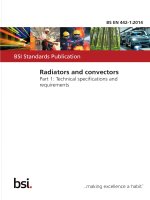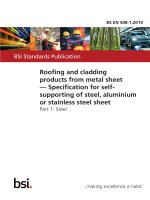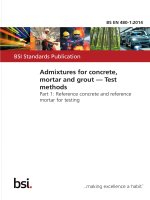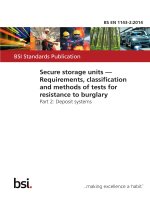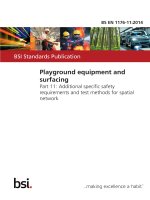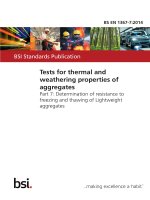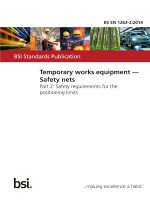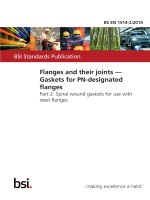Bsi bs en 61788 19 2014
Bạn đang xem bản rút gọn của tài liệu. Xem và tải ngay bản đầy đủ của tài liệu tại đây (1.87 MB, 48 trang )
BS EN 61788-19:2014
BSI Standards Publication
Superconductivity
Part 19: Mechanical properties
measurement — Room temperature
tensile test of reacted Nb3Sn
composite superconductors
BRITISH STANDARD
BS EN 61788-19:2014
National foreword
This British Standard is the UK implementation of EN 61788-19:2014. It is
identical to IEC 61788-19:2013.
The UK participation in its preparation was entrusted to Technical
Committee L/-/90, Super Conductivity.
A list of organizations represented on this committee can be obtained on
request to its secretary.
This publication does not purport to include all the necessary provisions of
a contract. Users are responsible for its correct application.
© The British Standards Institution 2014.
Published by BSI Standards Limited 2014
ISBN 978 0 580 72866 2
ICS 29.050; 77.040.10
Compliance with a British Standard cannot confer immunity from
legal obligations.
This British Standard was published under the authority of the
Standards Policy and Strategy Committee on 28 February 2014.
Amendments/corrigenda issued since publication
Date
Text affected
BS EN 61788-19:2014
EN 61788-19
EUROPEAN STANDARD
NORME EUROPÉENNE
EUROPÄISCHE NORM
February 2014
ICS 29.050; 77.040.10
English version
Superconductivity Part 19: Mechanical properties measurement Room temperature tensile test of reacted Nb3Sn composite
superconductors
(IEC 61788-19:2013)
Supraconductivité Partie 19: Mesure des propriétés
mécaniques Essai de traction à température ambiante
des supraconducteurs composites de
Nb3Sn mis en réaction
(CEI 61788-19:2013)
Supraleitfähigkeit Teil 19: Messung der mechanischen
Eigenschaften - Zugversuch von
reagierten Nb3Sn-Verbundsupraleitern bei
Raumtemperatur
(IEC 61788-19:2013)
This European Standard was approved by CENELEC on 2013-12-24. CENELEC members are bound to comply
with the CEN/CENELEC Internal Regulations which stipulate the conditions for giving this European Standard
the status of a national standard without any alteration.
Up-to-date lists and bibliographical references concerning such national standards may be obtained on
application to the CEN-CENELEC Management Centre or to any CENELEC member.
This European Standard exists in three official versions (English, French, German). A version in any other
language made by translation under the responsibility of a CENELEC member into its own language and notified
to the CEN-CENELEC Management Centre has the same status as the official versions.
CENELEC members are the national electrotechnical committees of Austria, Belgium, Bulgaria, Croatia, Cyprus,
the Czech Republic, Denmark, Estonia, Finland, Former Yugoslav Republic of Macedonia, France, Germany,
Greece, Hungary, Iceland, Ireland, Italy, Latvia, Lithuania, Luxembourg, Malta, the Netherlands, Norway, Poland,
Portugal, Romania, Slovakia, Slovenia, Spain, Sweden, Switzerland, Turkey and the United Kingdom.
CENELEC
European Committee for Electrotechnical Standardization
Comité Européen de Normalisation Electrotechnique
Europäisches Komitee für Elektrotechnische Normung
CEN-CENELEC Management Centre: Avenue Marnix 17, B - 1000 Brussels
© 2014 CENELEC -
All rights of exploitation in any form and by any means reserved worldwide for CENELEC members.
Ref. No. EN 61788-19:2014 E
BS EN 61788-19:2014
EN 61788-19:2014
-2-
Foreword
The text of document 90/328/FDIS, future edition 1 of IEC 61788-19, prepared by IEC/TC 90
"Superconductivity" was submitted to the IEC-CENELEC parallel vote and approved by CENELEC as
EN 61788-19:2014.
The following dates are fixed:
•
•
latest date by which the document has
to be implemented at national level by
publication of an identical national
standard or by endorsement
latest date by which the national
standards conflicting with the
document have to be withdrawn
(dop)
2014-09-24
(dow)
2016-12-24
Attention is drawn to the possibility that some of the elements of this document may be the subject of
patent rights. CENELEC [and/or CEN] shall not be held responsible for identifying any or all such
patent rights.
Endorsement notice
The text of the International Standard IEC 61788-19:2013 was approved by CENELEC as a European
Standard without any modification.
BS EN 61788-19:2014
EN 61788-19:2014
-3-
Annex ZA
(normative)
Normative references to international publications
with their corresponding European publications
The following documents, in whole or in part, are normatively referenced in this document and are
indispensable for its application. For dated references, only the edition cited applies. For undated
references, the latest edition of the referenced document (including any amendments) applies.
NOTE When an international publication has been modified by common modifications, indicated by (mod), the relevant EN/HD
applies.
Publication
Year
Title
EN/HD
Year
IEC 60050
series International Electrotechnical Vocabulary
-
-
ISO 376
-
Metallic materials - Calibration of forceEN ISO 376
proving instruments used for the verification
of uniaxial testing machines
-
ISO 6892-1
-
Metallic materials - Tensile testing EN ISO 6892-1
Part 1: Method of test at room temperature
-
ISO 7500-1
-
Metallic materials - Verification of static
EN ISO 7500-1
uniaxial testing machines Part 1: Tension/compression testing
machines - Verification and calibration of the
force-measuring system
-
ISO 9513
-
Metallic materials - Calibration of
extensometer systems used in uniaxial
testing
-
EN ISO 9513
–2–
BS EN 61788-19:2014
61788-19 © IEC:2013
CONTENTS
INTRODUCTION ..................................................................................................................... 7
1
Scope .............................................................................................................................. 8
2
Normative references ...................................................................................................... 8
3
Terms and definitions ...................................................................................................... 8
4
Principles ...................................................................................................................... 10
5
Apparatus ...................................................................................................................... 10
6
5.1
General ............................................................................................................ 10
5.2
Testing machine............................................................................................... 10
5.3
Extensometer ................................................................................................... 10
Specimen preparation .................................................................................................... 10
7
6.1
6.2
6.3
6.4
Testing
8
7.1
Specimen gripping ........................................................................................... 11
7.2
Setting of extensometer ................................................................................... 11
7.3
Testing speed .................................................................................................. 11
7.4
Test ................................................................................................................. 11
Calculation of results ..................................................................................................... 12
9
8.1
Modulus of elasticity (E) ................................................................................... 12
8.2
0,2 % proof strength (R p0,2-0 and R p0,2-U ) .................................................... 13
Uncertainty of measurand .............................................................................................. 13
10
Test report ..................................................................................................................... 13
General ............................................................................................................ 10
Length of specimen .......................................................................................... 10
Removing insulation ......................................................................................... 11
Determination of cross-sectional area (S 0 )....................................................... 11
conditions ......................................................................................................... 11
10.1
Specimen ......................................................................................................... 13
10.2
Results ............................................................................................................ 14
10.3
Test conditions ................................................................................................ 14
Annex A (informative) Additional information relating to Clauses 1 to 10 .............................. 16
A.1
A.2
A.3
A.4
A.5
A.6
A.7
A.8
A.9
A.10
A.11
A.12
A.13
Scope .............................................................................................................. 16
Extensometer ................................................................................................... 16
A.2.1
Double extensometer ...................................................................... 16
A.2.2
Single extensometer ....................................................................... 17
Optical extensometers ..................................................................................... 18
Requirements of high resolution extensometers ............................................... 19
Tensile stress R elasticmax and strain A elasticmax .......................................... 20
Functional fitting of stress-strain curve obtained by single extensometer
and 0,2 % proof strength (R p0,2-F ) .................................................................. 21
Removing insulation ......................................................................................... 22
Cross-sectional area determination .................................................................. 22
Fixing of the reacted Nb 3 Sn wire to the machine by two gripping
techniques ....................................................................................................... 22
Tensile strength (R m ) ...................................................................................... 23
Percentage elongation after fracture (A) .......................................................... 24
Relative standard uncertainty ........................................................................... 24
Determination of modulus of elasticity E 0 ......................................................... 26
BS EN 61788-19:2014
61788-19 © IEC:2013
–3–
A.14
Assessment on the reliability of the test equipment .......................................... 27
A.15
Reference documents ...................................................................................... 27
Annex B (informative) Uncertainty considerations ................................................................ 28
B.1
Overview .......................................................................................................... 28
B.2
Definitions ........................................................................................................ 28
B.3
Consideration of the uncertainty concept ......................................................... 28
B.4
Uncertainty evaluation example for TC 90 standards ........................................ 30
B.5
Reference documents of Annex B ................................................................... 31
Annex C (informative) Specific examples related to mechanical tests .................................. 33
C.1
Overview .......................................................................................................... 33
C.2
Uncertainty of the modulus of elasticity ............................................................ 33
C.3
Evaluation of sensitivity coefficients ................................................................. 34
C.4
Combined standard uncertainties of each variable ........................................... 35
C.5
Uncertainty of 0,2 % proof strength R p0,2 ........................................................ 38
Bibliography .......................................................................................................................... 43
Figure 1 – Stress-strain curve and definition of modulus of elasticity and 0,2 % proof
strengths for Cu/Nb 3 Sn wire ................................................................................................. 15
Figure A.1 – Light weight ultra small twin type extensometer ................................................ 16
Figure A.2 – Low mass averaging double extensometer ........................................................ 17
Figure A.3 – An example of the extensometer provided with balance weight and
vertical specimen axis ........................................................................................................... 18
Figure A.4 – Double beam laser extensometer ...................................................................... 19
Figure A.5 – Load versus displacement record of a reacted Nb 3 Sn wire ............................... 20
Figure A.6 – Stress-strain curve of a reacted Nb 3 Sn wire ..................................................... 21
Figure A.7 – Two alternatives for the gripping technique. ...................................................... 23
Figure A.8 – Details of the two alternatives of the wire fixing to the machine ......................... 23
Figure C.1 – Measured stress-strain curve ............................................................................ 33
Figure C.2 – Stress-strain curve ........................................................................................... 39
Table A.1 – Standard uncertainty value results achieved on different Nb 3 Sn wires
during the international round robin tests .............................................................................. 25
Table A.2 – Results of ANOVA (F-test) for the variations of E 0 ............................................. 26
Table B.1 – Output signals from two nominally identical extensometers ................................ 29
Table B.2 – Mean values of two output signals ..................................................................... 29
Table B.3 – Experimental standard deviations of two output signals ...................................... 29
Table B.4 – Standard uncertainties of two output signals ...................................................... 30
Table B.5 – Coefficient of Variations of two output signals .................................................... 30
Table C.1 – Load cell specifications according to manufacturer’s data sheet......................... 35
Table C.2 – Uncertainties of displacement measurement ...................................................... 36
Table C.3 – Uncertainties of wire diameter measurement ...................................................... 37
Table C.4 – Uncertainties of gauge length measurement ...................................................... 37
Table C.5 – Calculation of stress at 0 % and at 0,1 % strain using the zero offset
regression line as determined in Figure C.1 (b) ..................................................................... 38
Table C.6 – Linear regression equations computed for the three shifted lines and for
the stress – strain curve in the region where the lines intersect ............................................ 40
–4–
BS EN 61788-19:2014
61788-19 © IEC:2013
Table C.7 – Calculation of strain and stress at the intersections of the three shifted
lines with the stress – strain curve ........................................................................................ 40
Table C.8 – Measured stress versus strain data and the computed stress based on a
linear fit to the data in the region of interest .......................................................................... 41
BS EN 61788-19:2014
61788-19 © IEC:2013
–7–
INTRODUCTION
The Cu/Nb 3 Sn superconductive composite wires are multifilamentary composite materials.
They are manufactured in different ways. The first method is the bronze route, where fine Nb /
Nb alloy filaments are embedded in a bronze matrix, a barrier and a copper stabilizer. The
second is the internal-tin method, where fine multifilaments are composed with copper matrix
including Sn reservoirs, a barrier, and a copper stabilizer. The third is the powder-in-tube
method, where Nb / Nb alloy tubes are filled with Sn rich powders and are embedded in a Cu
stabilizing matrix.
Common to all types of Nb 3 Sn composite wires is that the superconducting A15 phase Nb 3 Sn
has been formed at final wire dimension by applying one or more heat treatments for several
days with a temperature at the last heat treatment step of around 640 °C or above. This
superconducting phase is very brittle and failure of filaments occurs – accompanied by the
degradation of the superconducting properties.
Commercial composite superconductors have a high current density and a small crosssectional area. The major application of the composite superconductors is to build
superconducting magnets. This can be done either by winding the superconductor on a spool
and applying the heat treatment together with the spool afterwards (wind and react) or by heat
treatment of the conductor before winding the magnet (react and wind). While the magnet is
being manufactured, complicated stresses are applied to its windings. Therefore the react and
wind method is the minority compared to the wind and react manufacturing process.
In the case that the mechanical properties should be determined in the unreacted, nonsuperconducting stage of the composite, one should also apply this standard or alternatively
IEC 61788-6 (Superconductivity– Part 6: Mechanical properties measurement – Room
temperature tensile test of Cu/Nb-Ti composite superconductors).
While the magnet is being energized, a large electromagnetic force is applied to the
superconducting wires because of their high current density. In the case of the react and wind
manufacturing technique, the winding strain and stress levels are very restricted.
It is therefore a prerequisite to determine the mechanical properties of the superconductive
reacted Nb 3 Sn composite wires of which the windings are manufactured.
–8–
BS EN 61788-19:2014
61788-19 © IEC:2013
SUPERCONDUCTIVITY –
Part 19: Mechanical properties measurement –
Room temperature tensile test of reacted Nb3Sn
composite superconductors
1
Scope
This part of IEC61788 covers a test method detailing the tensile test procedures to be carried
out on reacted Cu/Nb 3 Sn composite superconducting wires at room temperature.
The object of this test is to measure the modulus of elasticity and to determine the proof
strength of the composite due to yielding of the copper and the copper tin components from
the stress versus strain curve.
Furthermore, the elastic limit, the tensile strength, and the elongation after fracture can be
determined by means of the present method, but they are treated as optional quantities
because the measured quantities of the elastic limit and the elongation after fracture have
been reported to be subject to significant uncertainties according to the international round
robin test.
The sample covered by this test procedure should have a bare round or rectangular crosssection with an area between 0,15 mm 2 and 2,0 mm 2 and a copper to non-copper volume
ratio of 0,2 to 1,5 and should have no insulation.
2
Normative references
The following documents, in whole or in part, are normatively referenced in this document and
are indispensable for its application. For dated references, only the edition cited applies. For
undated references, the latest edition of the referenced document (including any
amendments) applies.
IEC 60050
(all
parts),
International
<>)
Electrotechnical
Vocabulary
(available
at
ISO 376, Metallic materials – Calibration of force-proving instruments used for the verification
of uniaxial testing machines
ISO 6892-1, Metallic materials – Tensile testing – Part 1: Method of test at room temperature
ISO 7500-1, Metallic materials – Verification of static uniaxial testing machines – Part 1:
Tension/compression testing machines – Verification and calibration of the force-measuring
system
ISO 9513, Metallic materials – Calibration of extensometer systems used in uniaxial testing
3
Terms and definitions
For the purposes of this document, the definitions given in IEC 60050-815 and ISO 6892-1, as
well as the following, apply.
BS EN 61788-19:2014
61788-19 © IEC:2013
–9–
3.1
tensile stress
R
tensile force divided by the original cross-sectional area at any moment during the test
3.2
strain
A
displacement increment divided by initial gauge length of extensometers at any moment
during the test
3.3
modulus of elasticity
E
gradient of the straight portion of the stress-strain curve in the elastic deformation region
3.4
extensometer gauge length
length of the parallel portion of the test piece used for the measurement of displacement by
means of an extensometer
3.5
distance between grips
Lg
length between grips that hold a test specimen in position before the test is started
3.6
0,2 % proof strength
R p0,2
stress value where the ductile components yield by 0,2 %.
Note 1 to entry: The designated proof strengths, R p0,2-0 and R p0,2-U correspond to point A or point C obtained
from unloading slope U between 0,3 % and 0,4 % in Figure 1(a), respectively. This strength is regarded as a
representative 0,2 % proof strength of the composite.
3.7
tensile strength
Rm
tensile stress corresponding to the maximum testing force
3.8
tensile stress at elastic limit
R elasticmax
tensile force divided by the original cross-sectional area at the transition of elastic to plastic
deformation
3.9
strain at elastic limit
A elasticmax
strain at the transition of elastic to plastic deformation
Note 1 to entry: The stress R elasticmax and the corresponding strain A elasticmax refer to point G in Figure A.6 o0f
Annex A.5 and are regarded as the transition point of elastic to plastic deformation.
– 10 –
4
BS EN 61788-19:2014
61788-19 © IEC:2013
Principles
The test consists of straining a test piece by tensile force beyond the elastic deformation
regime, in principle for the purpose of determining the modulus of elasticity (E) and the proof
strengths of R p0,2.
5
Apparatus
5.1
General
The test machine and the extensometers shall conform to ISO 7500-1 and ISO 9513,
respectively. The calibration shall obey ISO 376. The special requirements of this standard
are presented here.
5.2
Testing machine
A tensile machine control system that provides a constant stroke speed shall be used. Grips
shall have a structure and strength appropriate for the test specimen and shall be constructed
to provide a firm connection with the tensile machine. The faces of the grips shall be filed or
knurled, or otherwise roughened, so that the test specimen will not slip on them during testing.
Gripping may be screw type, pneumatically, or hydraulically actuated.
5.3
Extensometer
The mass of the extensometer shall be 30 g or depending on wire diameter even less, so as
not to affect the mechanical properties of the brittle reacted superconductive wire. The mass
of the extensometers had to be balanced symmetrically around the wire to avoid any nonalignment force (see Clause A.2). Care shall also be taken to prevent bending moments from
being applied to the test specimen.
Depending on the employed strain measuring method, however, the quantities determined by
the present test should be limited. When using the conventional single extensometer system,
the determination of E U and R p0,2-U is recommended. On the other hand, it is possible to
determine all quantities described here by using an averaging double extensometer system,
because of its capability to compensate the bending effects of the reacted sample and to
guarantee a proper determination of the modulus of elasticity E 0 .
NOTE
6
6.1
Further information is given in Clauses A.2 and A.3.
Specimen preparation
General
The wire should be straightened before heat treatment and should be inserted into a ceramic
or quartz tube with slightly larger inner diameter referring to the wire size.
The constant temperature zone length of the heat treatment furnace shall be longer than the
total length mentioned below in 6.2.
Care shall be taken to prevent bending or pre-loading when the reacted specimen is manually
handled during removal from the ceramic or quartz tube and mounting.
6.2
Length of specimen
The total length of the test specimen shall be the sum of inward distance between grips and
both grip lengths. The inward distance between grips shall be 60 mm or more, as requested
for the installation of the extensometers.
BS EN 61788-19:2014
61788-19 © IEC:2013
6.3
– 11 –
Removing insulation
If the test specimen surface is coated with an insulating material, the coating shall be
removed before the heat treatment. Either a chemical or mechanical method shall be used
with care taken not to damage the specimen surface (see Clause A.7).
6.4
Determination of cross-sectional area (S 0 )
A micrometer or other dimension-measuring apparatus shall be used to obtain the crosssectional area of the specimen after the insulation coating has been removed. The crosssectional area of a round wire shall be calculated using the arithmetic mean of the two
orthogonal diameters. The cross-sectional area of a rectangular wire shall be obtained from
the product of its thickness and width. Corrections to be made for the corners of the crosssectional area shall be determined through consultation among the parties concerned (see
Clause A.8).
7
7.1
Testing conditions
Specimen gripping
When the test specimen is mounted on the grips of the tensile machine, the test specimen
and tensile loading axis shall be on a single straight line with a minimum of machine/specimen
mismatch. Gripping techniques of specimen are described in Clause A.9.
7.2
Setting of extensometer
When mounting the extensometer, care shall be taken to prevent the test specimen from
being deformed. The extensometer shall be mounted at the centre between the grips, aligning
the measurement direction with the specimen axis direction.
During mounting care should be taken not to pre-load the specimen. After installation, loading
shall be physically zeroed.
Double extensometer shall be mounted symmetrically around the cross-section to allow
averaging of the strain to compensate the bending effects.
To guarantee best performance of the stress-strain curve of rectangular wires the
extensometer should be mounted in such a way that strain is measured symmetrically on the
small sides of the wire.
7.3
Testing speed
The tensile tests shall be performed with displacement control. The machine crosshead speed
is recommended to be set between 0,1 mm/min and 0,5 mm/min.
7.4
Test
Following this procedure the tensile machine shall be started after the crosshead speed has
been set to a specific level. The signals from the extensometers and the load cell shall be
recorded, saved, and plotted on the abscissa and ordinate of the diagram as shown in
Figures 1 (a) and 1 (b). When the total strain has reached a value between 0,3 % and 0,4 %
the tensile force shall be reduced by 30 % to 40 % without changing the crosshead speed.
Following this procedure the wire shall be reloaded again until final fracture.
Prior to the start of any material test program it is advisable to check the complete test
equipment using similar size wires of known elastic properties (See Clause A.14).
– 12 –
8
BS EN 61788-19:2014
61788-19 © IEC:2013
Calculation of results
8.1
Modulus of elasticity (E)
Modulus of elasticity shall be calculated in general using the following formula and the straight
portion of the unloading curve and of the initial loading one. Appropriate software for data
evaluation should be used for post analyses of the plotted data with the possibility of
enlargement of the stress versus strain graph, especially around the region where the
deviation from linearity is expected.
E = ∆F / (S 0 ∆A )
(1)
where
E
is the modulus of elasticity;
∆ F is the increment of the corresponding force;
∆ A is the increment of strain corresponding to ∆ F;
S 0 is the original cross−sectional area of the test specimen. Since unloading process is
carried out at the strain indicated by the point A U in Figure 1(a), the same Formula (1) is used
for both the unloading modulus of elasticity (E U ) and the initial loading one (E 0 ). It is
recommended to measure the unloading curve at the starting point A U , where A U is
recommended to be between 0,3 % and 0,4 %.
The modulus of elasticity determined from the unloading curve is expressed as E U which is
given by the slope of the line (U between 0,3 % and 0,4 % strain) in Figure 1(a) and that from
the initial loading curve is expressed as E 0 by the zero offset line.
It should be, however, noted that the straight portion of the initial stress – strain curve is very
narrow as indicated in Figure A.6 of Clause A.5. To measure this quantity with a low relative
standard uncertainty the only currently possible technique is the use of an averaging double
extensometer system. In this sense, the quantity of E U should be a representative data for
the present text, while E 0 should be reported only when the measure is performed by means
of double extensometer system.
After the test, the results shall be examined using the ratio E 0 /E U . The ratio shall satisfy the
condition as given in Equation 2 in which ∆ = 0,3 (see Clause A.12).
1- ∆ < E 0 /E U < 1+ ∆
(2)
When it does not satisfy the condition, the test is judged not to be valid. Then the test shall be
repeated after the experimental procedure is reexamined according to the present test
method.
It is guided to achieve the unloading-reloading procedure as follows: when the loading curve
arrives at the strain A U (between 0,3 % and 0,4 %), the stress is reduced to r umin of the
maximum stress (stress position where the unloading started r umax) and then the wire is
reloaded. The slope of the unloading curves shall be obtained in the linear portion between
the stress r umax and r umin .
NOTE 3 Typical range of r umax is 99 % of the maximum stress (stress where the unloading starts). The range of
r umin is at 90 % referring to the onset of the unloading stress (see Figure 1 (b)).
BS EN 61788-19:2014
61788-19 © IEC:2013
8.2
– 13 –
0,2 % proof strength (R p0,2-0 and R p0,2-U )
The 0,2 % proof strength of the composite is determined in two ways from the
unloading/reloading and initial loading part of the stress-strain curve as shown in Figures 1(a)
and 1(b).
The 0,2 % proof strength of the composite under unloading R p0,2-U shall be determined as
follows: the linear portion of the unloading slope is moved parallel to the origin of the fitted
curve, which may include a negative strain value. Thereafter, a parallel line shall be shifted to
0,2 % on the abscissa from this strain point. The intersection of this line U with the stressstrain curve determines the point C that shall be defined as the 0,2 % proof strength.
Depending of the unloading line (e. g. U 0,35 in Fig 1(a)), 0,2 % proof strength (R p0,2-U ) is
determined.
The 0,2 % proof strength under loading R p0,2-0 shall be determined as follows: the initial linear
portion at zero offset position of the loading line of the stress-strain curve is moved 0,2 %
along the strain axis and the point A at which this linear line intersects the stress-strain curve
shall be defined as the 0,2 % proof strength under loading.
Each of 0,2 % proof strength value shall be calculated using the formula (3) given below:
Rp0,2 − i = Fi / S0
(3)
where
R p0,2-i
is the 0,2 % proof strength (MPa) at each point;
Fi
is the force (N) at each point;
as i = 0 or U.
9
Uncertainty of measurand
Unless otherwise specified, measurements shall be carried out in a temperature that can
range from 283 K to 308 K. A force measuring cell with the relative standard uncertainty less
than 0,1 %, valid between zero and the maximum force capacity of load cell shall be used.
The extensometers should have the relative standard uncertainty of strain less than 0,05 %.
The displacement measuring transducer (e.g. LVDT [linear variable differential transformer])
used for the calibration should have the relative standard uncertainty less than 0,01 %.
The relative standard uncertainty values of measured moduli of elasticity E 0 and E U and the
proof strengths R p0,2-0 and R p0,2-U currently achieved with respect to the international round
robin test of eleven representative research groups are given in Table A.1 (see Clause A.12).
According to the international round robin test (see (9) of Clause A.15), the relative standard
uncertainty was reported to be 1,4 % for E 0 for the test data of N = 17 in average after the
qualification check. Similarly, 1,3 % for E U (N = 15), 1,5 % for R p0,2-0 (N = 17) and 2,5 % for
R p0,2-U (N = 13) were reported.
10 Test report
10.1
Specimen
The following information shall be reported:
a) Name of the manufacturer of the specimen
b) Classification and/or symbol
– 14 –
BS EN 61788-19:2014
61788-19 © IEC:2013
c) Lot number
The following information shall be reported if possible:
d) Raw materials and their chemical composition
e) Cross-sectional shape and dimension of the wire
f)
Filament diameter
g) Number of filaments
h) Copper to non-copper ratio
10.2
Results
Results of the following mechanical properties shall be reported.
a) Modulus of elasticity (E 0 and E U )
b) 0,2 % proof strengths (R p0,2-0 and R p0,2-U )
The following information shall be reported if required:
c) Tensile stress R elasticmax
d) Strain A elasticmax
e) Tensile strength (R m )
f)
Percentage elongation after fracture (A)
g) 0,2 % proof strength determined by means of function fitting method (R p0,2-F )
10.3
Test conditions
The following information shall be reported:
a) Crosshead speed
b) Distance between grips
c) Temperature
d) Manufacturer and model of testing machine
e) Manufacturer and model of extensometers
f)
Gripping method
BS EN 61788-19:2014
61788-19 © IEC:2013
– 15 –
Eu E0
300
0,2 %
250
H
0,2 %
A
200
Stress (MPa)
U
C
150
100
50
0
0,0
0,1
0,2
0,3
Au
0,4
0,5
0,6
0,7
Strain (%)
(a)
Stress (MPa)
145
145
135
135
0,8
IEC 2772/13
umax
rrum
ax
umin
rrum
in
Maximum
Maximum
stress
stress
125
125
115
115
105
105
0,320
0,320
(b)
b)
0,330
0,330
0,340
0,340
Strain (%)
Strain,
%
0,350
0,350
IEC 2773/13
The Figure 1(a) shows the over-all relation between stress and strain; (b) is the enlarged view indicating the unload
and reload procedure.
Key
U:
Computed unloading line of U between 0,3 % and 0,4 % strain using 1st order regression line in Figure
1(a)
Point A:
0,2 % strain shift from initial origin of the loading line (zero offset line). R p0,2-0 obtained experimentally.
Point C:
Point H:
0,2 % strain shift from origin of fit curve with the determined slope of unloading line U (e.g. U 0,35 ).
R p0,2-U is obtained by computation.
Final fracture point of the wire.
The slope of the initial loading line is usually smaller than that of the unloading lines. In such cases the line has to
be drawn from 0,2 % offset point on the abscissa to obtain 0,2 % proof strength (R p0,2-0 ) of the composite due to
yielding of the ductile components such as copper and bronze (point A). Point A is obtained from the initial loading
line.
Point C is obtained using the unloading line. The slope of the unloading line between 0,3 % and 0,4 % should be
shifted to the origin of the fit curve, which may include a negative strain shift (see Clause A.6). The parallel 0,2 %
strain shift of this slope as a line on the abscissa intersects the fitted curve at point C, which is defined as the
0,2 % proof strength of the composite (R p0,2-U ).
The graph in Figure 1(b) shows the raw data of the unloading region. The slope should be determined between
99 % of maximum stress at the onset of unloading and 90 % stress of the maximum stress as indicated (see 8.1).
Figure 1 – Stress-strain curve and definition of modulus
of elasticity and 0,2 % proof strengths for Cu/Nb 3 Sn wire
– 16 –
BS EN 61788-19:2014
61788-19 © IEC:2013
Annex A
(informative)
Additional information relating to Clauses 1 to 10
A.1
Scope
This annex gives reference information on the variable factors that may affect the tensile test
methods. All items described in this annex are informative.
A.2
A.2.1
Extensometer
Double extensometer
Any type of extensometer can be used if it consists of two single extensometers capable of
recording two signals to be averaged by software or one signal already averaged by the
extensometer system itself.
In Figures A.1 and A.2 typical advanced light weight extensometers are shown.
12,3
∼0,5 g
IEC 2166/13
Dimensions in millimetres
The extensometer has a gauge length of ~ 12 mm (total mass ~ 0,5 g). The two extensometers are wired together
into a single type extensometer, thus averaging the two displacement records electrically.
Figure A.1 – Light weight ultra small twin type extensometer
BS EN 61788-19:2014
61788-19 © IEC:2013
– 17 –
25,6
∼3 g
IEC 2167/13
Dimensions in millimetres
The extensometer has a gauge length of ~ 26 mm (total mass ~ 3 g). Each of the two extensometers is a single
type extensometer, the averaging should be carried out by software.
Figure A.2 – Low mass averaging double extensometer
A.2.2
Single extensometer
Figure A.3 shows a single extensometer with a total weight of 31 g together with a balance
weight. It was used during a RRT for Cu/Nb-Ti wires conducted in Japan and sound results
were obtained. The results were used to establish the international standard (IEC 61788-6)
[3, 4] 1.
___________
1
Figures in square brackets in this annex refer to the Reference documents listed in Clause A.15
BS EN 61788-19:2014
61788-19 © IEC:2013
13
– 18 –
Bar spring
a) Top view
Specimen
Stopper
Balance weight
Strain gauge
37
G.L. 25
Frame
22
35
Cross spring plate
Frame
Gauge length setting hole
b) Side view
IEC 2168/13
Dimensions in millimetres
Figure A.3 – An example of the extensometer provided
with balance weight and vertical specimen axis
A.3
Optical extensometers
Any type of optical extensometer can be used if it is based on two single optical beams,
where the signal can be recorded and averaged.
Alternatively, systems without mechanical contact to the specimen can also be used in a way
similar to an averaging double extensometer system based either on two laser beams or on
two other optical systems.
Figure A.4(a) shows schematically the scan of the stripes with 50 Hz of the rotating deflector.
The small displacement changes during the loading of the specimen are analyzed by the
BS EN 61788-19:2014
61788-19 © IEC:2013
– 19 –
software. Figure A.5(b) shows the picture of the double mirror arrangement of a typical
advanced double laser beam system.
Specimen with stripes
Scanning range
Scanning direction
Gripping
Specimen
with grading
Rotating deflector
Mirror N° 2
Mirror N° 1
Laser
IEC 2774/13
(a)
Schematic illustration
(b)
Overview of the present extensometer
Stress (MPa)
20
15
10
5
0
0,00
0,01
Strain (%)
(c)
0,02
IEC 2775/13
The results of a reacted Nb 3 Sn wire with 0,81 mm Ø
measured with a double beam laser extensometer.
Figure A.4 – Double beam laser extensometer
A.4
Requirements of high resolution extensometers
The requirements for such extensometers can well be derived from Figure A.5. Considering
the target that the recorded values plotted from the raw data should have a low relative
standard uncertainty, in particular between zero % strain and 0,01 % strain, the total
displacement in this range will be 2,5 µm for the case of 25 mm gauge length or 1,2 µm for
12 mm gauge length. In fact, the signals should be acquired with a low noise around
100 times better to ensure stable records within the required strain range. The calibration
factor of the used 12 mm gauge length extensometer is 10 V per 1 mm displacement. The V pp
of the signal should be less than 1 mV to ensure this low relative standard uncertainty. Using
state-of-the-art signal conditioners, shielded and twisted cables and high resolution data
acquisition systems of > 16 bit resolution, it is thus possible to ensure this demand. Figure A.5
shows the original raw data of the reacted Nb 3 Sn measurement in form of load versus
BS EN 61788-19:2014
61788-19 © IEC:2013
– 20 –
displacement graph. To achieve the low scatter of the data shown it is necessary to have a
high signal to noise ratio enabling to resolve the curve well below the 1 µm range [5,6,8,9] 2.
To obtain a zero offset gradient with a sufficient low relative standard uncertainty, which
allows an assessment for the modulus of elasticity, it is prerequisite to use high resolution
extensometers with extreme low noise to signal ratio.
The double extensometer system based either on two mechanical extensometers, on two
laser beams, or on two other optical systems arranged symmetrically in a 180° sector to each
beam may guarantee a compensation of the bending.
1010
88
Load
= 4878.7Displacement
Load
= 4878,7
2
Displacement + 0,0254
R = 0.9968
+ 0.0254
2
Load (N)
Load, N
R = 0,9968
66
44
22
00
0,000
0,0E+00
0,001
1,0E-03
Displacement (mm)
Displacement, mm
0,002
2,0E-03
IEC 2776/13
This figure shows the necessary low relative standard uncertainty with respect to the displacement resolution. The
data are taken from the measurement of the sample as shown in Figure A.1.
Figure A.5 – Load versus displacement record of a reacted Nb 3 Sn wire
A.5
Tensile stress R elasticmax and strain Aelasticmax
The tensile stress at which the transition of elastic to plastic deformation occurs is calculated
in general using the following formula (Figure A.6).
R elasticmax = Felasticmax / S 0
(A.1)
where
R elasticmax
is the tensile stress (MPa) at the transition of elastic to plastic deformation;
F elasticmax
is the force (N) at the transition of elastic to plastic deformation.
The strain at which the transition of elastic to plastic deformation occurs (Figure A.6) referred
to the stress R elasticmax is defined as follows:
∆Atotal = Amax − A0
___________
2
Figures in square brackets in this annex refer to the Reference documents listed in Clause A.15
(A.2)
BS EN 61788-19:2014
61788-19 © IEC:2013
– 21 –
where
∆Atotal
is the total strain increment referring to zero offset strain and to strain where the
transition of elastic to plastic deformation occurs;
Amax
is the observed value of strain referred to the stress R elasticmax ;
A0
is the zero offset strain.
The values R elasticmax and A elasticmax are treated as being of informative character.
30
Stress (MPa)
25
20
Relasticmax
G
15
10
Aelasticmax
5
0
0,000
0,010
0,020
Strain (%)
0,030
IEC 2777/13
This is the enlarged figure up to the transition region of the elastic plastic deformation (point G). The plots (large
circles) show the region of the initial straight portion of the record. The linear 1 st order regression analysis gives
the modulus of elasticity E (E 0 = 134,7 GPa) and the measure of linearity as square of regression coefficient. The
value of computed 0,188 MPa is the result of the regression line analysis, where the origin has been determined to
have an offset in the ordinate owing to the plot scatter. In addition, the square of regression coefficient should be
greater than 0,99 to ensure the linearity. The stress R elasticmax and the corresponding strain A elasticmax
correspond to the transition region of elastic plastic deformation. In particular, the value of R elasticmax is an
important quantity for the judgment of the determined E 0 . A low value of R elasticmax (e.g. < 5 MPa) may indicate a
higher uncertainty for the E 0 owing to the small portion of the linear region. The smaller linear range has an impact
for the measurand E 0 towards high uncertainty due to the data scatter. The uncertainty may raise the question of
repeating the measurement.
Figure A.6 – Stress-strain curve of a reacted Nb 3 Sn wire
A.6
Functional fitting of stress-strain curve obtained by single extensometer
and 0,2 % proof strength (Rp0,2-F )
The functional fitting method is applicable to determine the 0,2 % proof strength in the case of
single extensometer. Usually, constitute materials of copper and bronze in the Cu/Nb 3 Sn wire
have been yielded during cooling from heat-treatment temperature to room temperature. The
stress-strain curve, therefore, is curved from the beginning in the strict sense and the
evaluation of initial modulus of elasticity becomes difficult. Furthermore, due to the nonstraight form of the specimen as heat-treated condition and pre-straining on handling during
setting to the tensile testing machine, the stress-strain curve is bent concave or convex,
hence it is difficult to estimate the intrinsic zero strain point. The functional fitting method is
effective to exclude such strain included in the experimental data. The stress-strain curves
can be approximated by the following exponential function:
F / S 0 = a(A − b )n
(A.3)
where F, S 0 and A are load, cross section and strain obtained by the test, a, b and n are
parameters determined by non-linear least-mean-square-fitting. In order to avoid losing digits
– 22 –
BS EN 61788-19:2014
61788-19 © IEC:2013
during calculation, A is expressed in %. The upper bound of fitting is 0,5 % and the lower
bound of fitting is increased until the three parameters converge.
The 0,2 % proof strength R p0,2-F of the composite due to yielding of the copper and bronze
components by function fitting method is determined as follows; the linear portion under
unloading is to be moved parallel to the 0,2 % offset point with regard to the zero strain point
defined by the parameter b. The intersection of this line with the fitted stress – strain curve
determines the point C that is defined as the 0,2 % proof strength (Figure 1(a)). Fitting by
simplified equation of (A.3) by excluding the parameter b, means neglect of pre-strain and
gives larger proof stress value close to the R p0,2-F . It is reported that commercially available
non-linear least-square-fitting software can produce results almost identical to the
experimental data for the same parameters, if the allowable error is selected to less than 0,1
[1,2] 3. However, the confirmation of coincidence between data points and the fitting curve is
made.
A.7
Removing insulation
The coating on the surface of the test specimen should be removed using an appropriate
method. Normally the Nb 3 Sn conductors are braided with glass or ceramic fibers which can be
easily removed by stripping or peeling. In case of other type of insulation one should use
either an organic solvent or a mechanical method. In both case one may do this before the
heat treatment reaction and may avoid any damage of the specimen surface.
The coating is not designed as a structural component. An analysis of measurement as a
multi component composite including insulation is too complicated to perform. Therefore, this
test method covers only the bare reacted wire in order to maintain the mechanical behavior of
the wire.
A.8
Cross-sectional area determination
In case a smaller relative standard uncertainty is required, the cross-sectional area may be
obtained by correcting the radius of the corner of the rectangular wire finished by dies, using
the value given on the manufacturing specifications. For rolling or Turk's-head finish, the
radius of the corner is not controlled and a correction is made using a macro photograph of
the cross-section.
A.9
Fixing of the reacted Nb 3 Sn wire to the machine by two gripping
techniques
For gripping, the specimen may be soft soldered to a metallic sleeve in the region of the grips.
These sleeves should provide a firm gripping to the machine's pull rods. Alternatively a
gripping can be envisaged by chucking the wire itself. In this case it should be ensured that
the wire inside the chucks is not damaged mechanically. The test specimen is mounted using
the grips of the tensile machine. In any case, the test specimen and tensile loading axis are
aligned to disclose a mismatching. During mounting of the sample, it is necessary to prevent
bending or deformation.
According to the international round robin test results, several kinds of gripping techniques
were allowable to get proper test results. Therefore it is recommended that the gripping
technique proposed in the present standard be treated as one of various possible techniques.
___________
3
Figures in square brackets in this annex refer to the Reference documents listed in Clause A.15
BS EN 61788-19:2014
61788-19 © IEC:2013
– 23 –
IEC 2778/13
Figure A.7 – Two alternatives for the gripping technique.
The left image shows gripping of the soldered Nb 3 Sn wire into a M6 brass thread, which is
fixed with an aluminum sleeve serving the pulling action. The total mass of the sleeve
together with the M6 thread is around 12 g.
10
12
20
The right portion of the image shows the clamping of the bare Nb 3 Sn wire inside a V-groove
of an aluminum block. The total mass of the block is around 7 g. This block inserted into a
small frame acts as a defined fixture for the pulling action.
M6
∅20
Nb3Sn wire soldered into
the M6 brass thread
∅20
Nb3Sn wire fixed inside
the Al-block using two M3 screws
IEC 2779/13
Dimensions in millimetres
The drawings show details of the two alternative possibilities of the wire fixing to the machine, by soldering and by
clamping. In any case prior to the measurement start it is not allowed to load the wire with a pre-load. The bottom
end of the wire with the fixing block should be free of any contact to the machine to avoid any pre-loading.
Figure A.8 – Details of the two alternatives of the wire fixing to the machine
A.10 Tensile strength (Rm )
The tensile strength at which the fracture occurs is calculated using the following formula.

